I recently purchased a dagger at the 'marketplace' here, said to be ca. late 1800s, of Spanish origin. A curious piece that grabbed my attention.
[ Linked Image ]
As you can see it's got a fairly heavy patina. So my questions for everyone concerns the topic of patinas.
What is the thinking about patinas? It's been my understanding that patinas are generally to be left alone. Eventually though, I would assume this dagger could be overwhelmed and the various details lost.
When if ever do you remove or lessen a patina?
Is there a point when the patina is actually destructive to the metal?
Thanks, I appreciate your thoughts.
Jon
It's my opinion that patina is generally a good thing -- it's attractive, and imparts character to a blade. And it does offer some degree of protection (not a lot, though, you still have to oil it).
My simple stand-by rule for patina:
Black = Good
Red = Bad
Probably oversimplified, but there you go.
My simple stand-by rule for patina:
Black = Good
Red = Bad
Probably oversimplified, but there you go.
You will destroy the value of an antique by changing the finish. If you must, you can have something professionally, and hopefully gently, restored... or better, stabilized. However, even that often reduces the value of an antique.
If it is an antique, I would just leave it as is. As others said, the value of the item will drop if cleaned off.
I'm glad this rather interesting dagger found a new home, pretty fast.
When dealing with old or antique things, a subject to take in consideration is the amount of patina and its appearance. Here we can see good patina on all parts - steel blade, brass guard & pommel (with nice appealing 'rubbing points'), and even the wooden grip.
When dealing with old or antique things, a subject to take in consideration is the amount of patina and its appearance. Here we can see good patina on all parts - steel blade, brass guard & pommel (with nice appealing 'rubbing points'), and even the wooden grip.
Thanks to everyone for the information. As thought, and now confirmed, I will certainly leave this dagger as is. I have applied an oil to prevent any rust and that's it.
I also have a Bronze Age dagger reproduction with some bright blue spotting beginning on the bronze blade. I then assume, like the dark patina on the dagger shown above, that 'hands off' is the best policy.
So, what I'm coming away with here is that the only time any patina removal would be warranted would be if the metal detailing was completely covered, obscured. And then have it done professionally, carefully, and partially.
Jon
I also have a Bronze Age dagger reproduction with some bright blue spotting beginning on the bronze blade. I then assume, like the dark patina on the dagger shown above, that 'hands off' is the best policy.
So, what I'm coming away with here is that the only time any patina removal would be warranted would be if the metal detailing was completely covered, obscured. And then have it done professionally, carefully, and partially.
Jon
| J. Hargis wrote: |
| ...I also have a Bronze Age dagger reproduction with some bright blue spotting beginning on the bronze blade. I then assume, like the dark patina on the dagger shown above, that 'hands off' is the best policy.... |
I'm interested to hear what others think about contemporary reproductions. My feeling has also been different for reproductions, namely, that they should look like the originals would have in period. I imagine this is personal preference?
| J. Hargis wrote: |
|
I also have a Bronze Age dagger reproduction with some bright blue spotting beginning on the bronze blade. I then assume, like the dark patina on the dagger shown above, that 'hands off' is the best policy. |
With a reproduction it more or less comes down to personal preference. However the only reason I can imagine why one would want corrosion on a reproduction is to make it resemble an antique. The blue spots are new corrosion so it's not exactly an antique look.
There is a broad range of perception and application in care. A good many antiques will suffer no damage or loss in careful cleaning. To me, there is a difference between grunge and hard patina. Even then, I often debate whether to go further with a piece. Many antiques have accumulated "patina" that is actually damage.
Someplace between restoration and basic cleaning is conservation. Conservation might imply stabilizing but cleaning usually comes first (in my shed). Cleaning to me is an evaluation at the same time. An organic grip component may benefit from tricks and nourishment. Brass that has become encrusted by acidic soot from living over a fireplace can be cleaned to a state that is not burnished or polished mirror bright (which I think some actually like in conservation). Cleaning might be as simple as a light wipe with an oily rag but what about others parts? Sometimes just dusting off loose dirt is all a piece may benefit from.
Careful cleaning and conservation can actually increase street value considerably. That may be considered restoration and maybe that is a valid description. To bring a piece back to serviceable and presentable appearance.
Hard patina that resists mild cleaning is often best left alone and I have some examples of those as well but I rarely avoid cleaning grunge when gilt lays below. The oxidized branched sabre below was taken down to the brass and the grip leather treated.
I have also removed active rust from blades that would otherwise continue to degrade as the decades and centuries plod on.
There is nothing wrong with the philosophy of do nothing but some will eventually degrade further.
Cheers
GC
 Attachment: 45.57 KB
Attachment: 45.57 KB
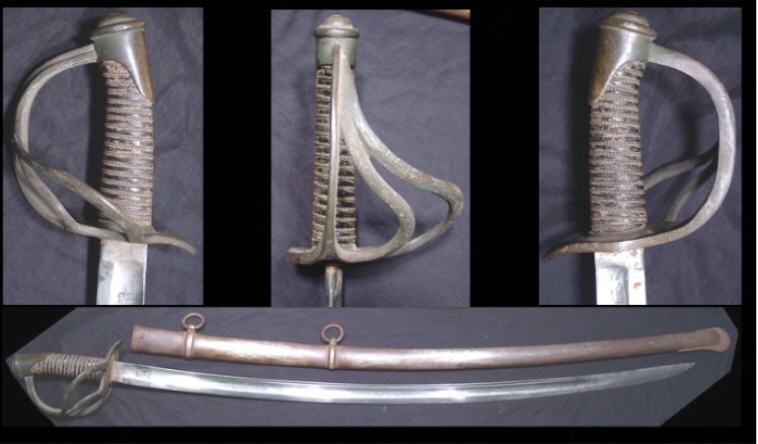
as was
 Attachment: 137.09 KB
Attachment: 137.09 KB
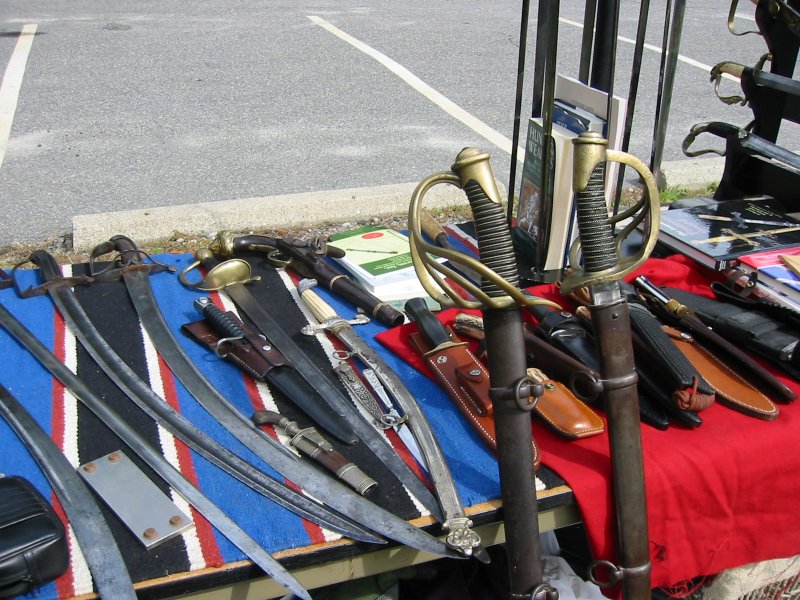
cleaned and nurtured
 Attachment: 48.86 KB
Attachment: 48.86 KB
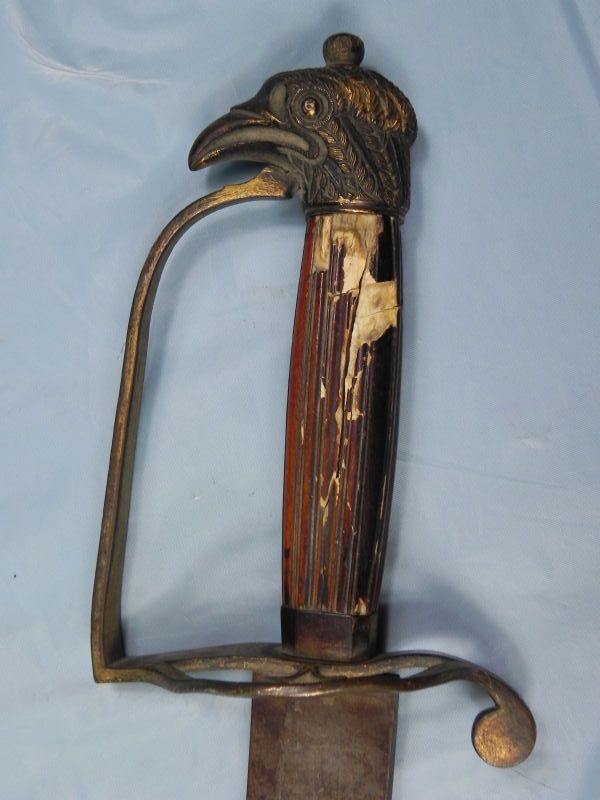
soot/fire damage
 Attachment: 96.67 KB
Attachment: 96.67 KB
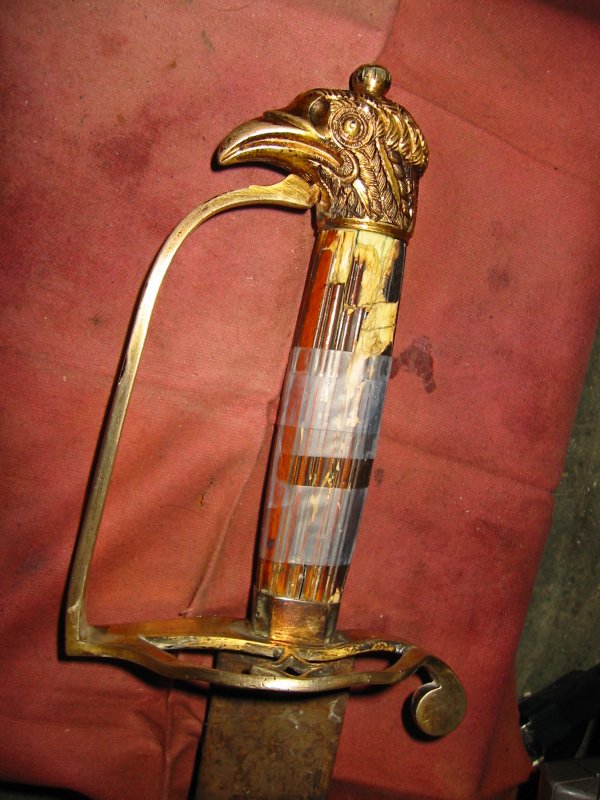
Grip in progress Gilt wiped clean
 Attachment: 131.82 KB
Attachment: 131.82 KB
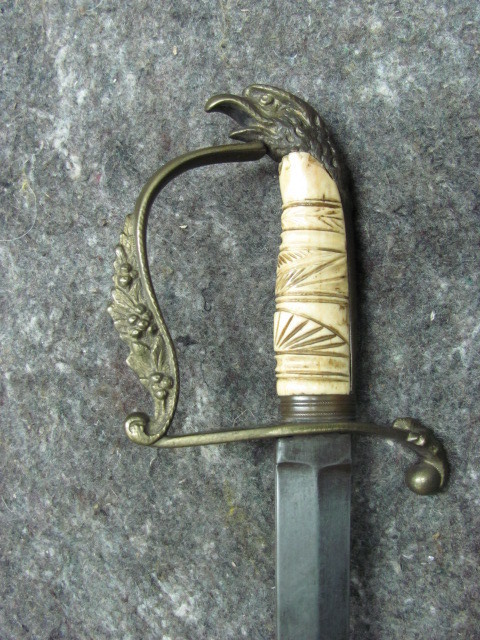
grunge found inexpensively and ignored in listings
 Attachment: 75.58 KB
Attachment: 75.58 KB
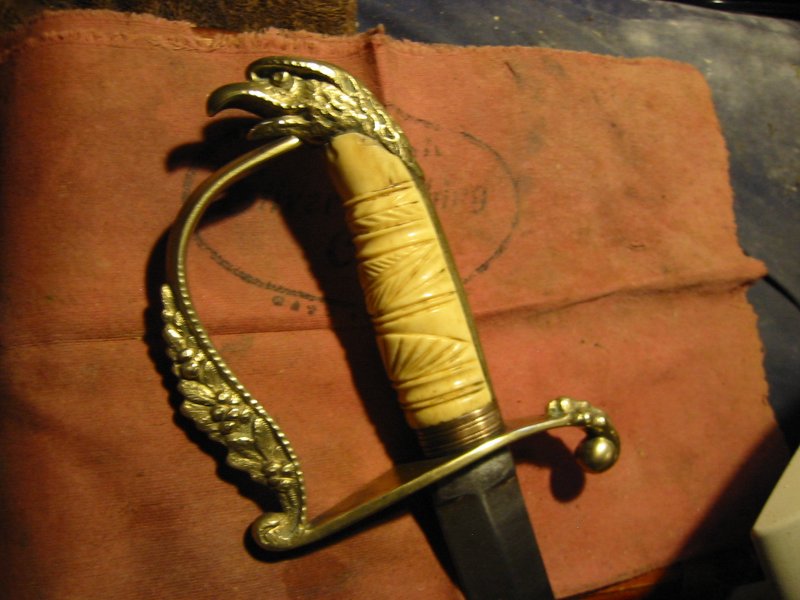
Cleaned gilt.
Someplace between restoration and basic cleaning is conservation. Conservation might imply stabilizing but cleaning usually comes first (in my shed). Cleaning to me is an evaluation at the same time. An organic grip component may benefit from tricks and nourishment. Brass that has become encrusted by acidic soot from living over a fireplace can be cleaned to a state that is not burnished or polished mirror bright (which I think some actually like in conservation). Cleaning might be as simple as a light wipe with an oily rag but what about others parts? Sometimes just dusting off loose dirt is all a piece may benefit from.
Careful cleaning and conservation can actually increase street value considerably. That may be considered restoration and maybe that is a valid description. To bring a piece back to serviceable and presentable appearance.
Hard patina that resists mild cleaning is often best left alone and I have some examples of those as well but I rarely avoid cleaning grunge when gilt lays below. The oxidized branched sabre below was taken down to the brass and the grip leather treated.
I have also removed active rust from blades that would otherwise continue to degrade as the decades and centuries plod on.
There is nothing wrong with the philosophy of do nothing but some will eventually degrade further.
Cheers
GC

as was

cleaned and nurtured

soot/fire damage

Grip in progress Gilt wiped clean

grunge found inexpensively and ignored in listings

Cleaned gilt.
I want to share another here as example. This urn pommel sword had first hit my files in 2008, as it passed from one collector to another. The same fellow bought it back and this past year was put up for sale once more. It rests right next to me as I type and has been right there all this past quarter while I pondered exactly the same fate of cleaning or not. The bright blue background are from 2008, then from Xmas time and the pinkish cloth just moments ago here, having been dusted and wiped with a mild solvent/cleaner. It is one I will not hit with deeper cleaning.
Cheers
GC
 Attachment: 17.03 KB
Attachment: 17.03 KB

2008
 Attachment: 126.49 KB
Attachment: 126.49 KB
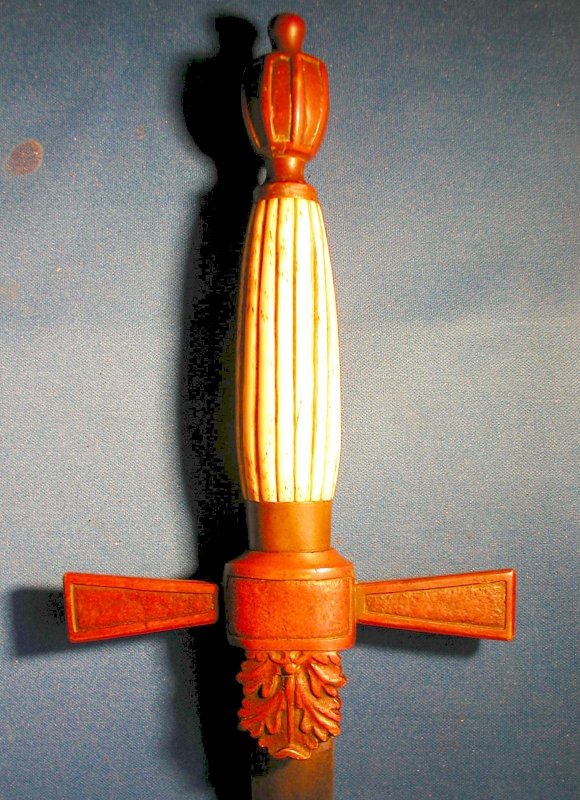
Xmas 2011
 Attachment: 81.78 KB
Attachment: 81.78 KB

wiped today
Cheers
GC

2008

Xmas 2011

wiped today
Page 1 of 1
You cannot post new topics in this forumYou cannot reply to topics in this forum
You cannot edit your posts in this forum
You cannot delete your posts in this forum
You cannot vote in polls in this forum
You cannot attach files in this forum
You can download files in this forum
All contents © Copyright 2003-2006 myArmoury.com — All rights reserved
Discussion forums powered by phpBB © The phpBB Group
Switch to the Full-featured Version of the forum
Discussion forums powered by phpBB © The phpBB Group
Switch to the Full-featured Version of the forum